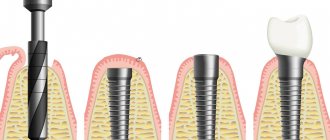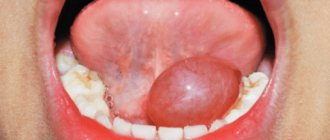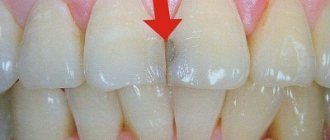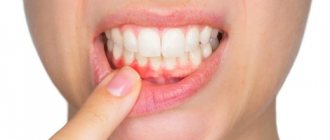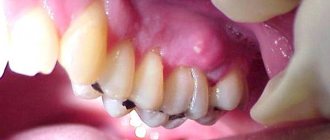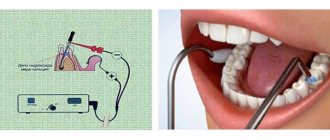Comment by the chief physician of the Family Dental S.V. Tsukora: “A dental cyst can be cured in different ways. Using the example of one patient, we want to show what options there may be and how a doctor chooses a treatment method. The result of treating a dental cyst should be the same – complete elimination of inflammation and restoration of bone tissue.”
The patient came to the Family Dentistry with complaints of pain in the lower chewing tooth on the right. Upon examination, there is an old large filling on the tooth. The dentist noticed that on the other side of the lower jaw in the chewing tooth there is also an old filling, but the tooth there does not cause problems.
A panoramic photograph of the teeth was taken to assess the condition of the roots. The panoramic image shows a tooth cyst on the right, and good condition of the tooth roots on the left after root canal treatment (the treatment was carried out in another clinic).
The cause of the dental cyst was chronic pulpitis, which developed due to a violation of the tightness of the old filling and the penetration of bacteria into the cavity and roots of the tooth.
Treatment of a dental cyst with a microscope
The old filling has been removed. The tooth was treated under a microscope, the canals were cleaned of infected tissue, thoroughly washed, and medicine was applied to completely eliminate the infection in the canals. During the second visit, the canals are again washed, dried and hermetically sealed.
Dental treatment under a microscope improves the quality of canal treatment, since a doctor armed with a microscope sees the area of work better, the canals are cleaned more thoroughly, there are no problems with narrow and highly convoluted canals, and additional canals that have a common entrance with the main ones do not go unnoticed.
A dentist-endodontist performs root canal treatment at Dial-Dent. An endodontist works with special instruments, always uses a microscope when working, and constantly improves his skills in treating dental canals, since dentistry does not stand still, offering new technologies. Treatment of tooth canals under a microscope allows you to successfully cure a cyst at the roots of a tooth without removing the tooth. Elimination of the source of inflammation leads to complete restoration of bone tissue at the roots of the teeth.
After treatment, the tooth was restored with a crown, since after canal treatment the tooth becomes more fragile, and it is not recommended to restore it with a filling to avoid splitting the tooth.
A control panoramic image was taken a year and a half later at the next scheduled examination:
The photo shows the restoration of bone tissue at the roots of the treated tooth.
A panoramic photograph makes it possible to assess the condition of all teeth. In this case, a panoramic photograph was taken, since the tooth on the left, in which canals were treated a long time ago (not at Dial-Dent), needs observation. The picture shows that his condition is normal.
Is it possible to cure on my own?
Patients often wonder whether it is possible to get rid of a tumor at home with the help of antibiotics? Of course not. Antibacterial drugs are used only as a comprehensive treatment to reduce the likelihood of developing a bacterial infection.
Self-medication can lead to the fact that the process of development of the neoplasm will occur in a latent form, that is, the patient can only get rid of superficial symptoms with the help of medications, but the cyst will develop as before and sooner or later will lead to irreversible consequences.
Cyst on a long-treated tooth
The patient returned 4 years later for a routine examination. No complaints. The dentist took a panoramic photo of the teeth. The panoramic image revealed a dental cyst on the left, where for a long time everything was absolutely normal. Since this tooth had a removed nerve, nothing bothered the patient, and the cyst had already reached a significant size and could have spread further to neighboring teeth.
The cause of a cyst in a tooth with canals treated long ago was most likely a fracture of the tooth root. This happens to teeth that have had the nerve removed because they are more fragile. This is why you need to visit the dentist regularly. A dental cyst can be asymptomatic, affecting tooth after tooth, which can lead to tooth loss. At Dial-Dent, during a routine appointment, the dentist carefully examines previously treated teeth and takes dental x-rays.
If a tooth root is fractured or cracked, conservative treatment is not effective. In this case, the best way to treat a dental cyst is to remove the tooth.
After extraction, the tooth must be restored. To restore the tooth, it was decided to perform implantation and install a ceramic crown on the dental implant.
Surgical intervention
In most cases, removal of the cyst is required. Do not be intimidated by this procedure; the minimally invasive intervention is performed under anesthesia at the patient’s request. Cyst removal is done in various ways:
- Laser technique. Removal is carried out using laser radiation. The technique is absolutely painless.
- Hemisection. This removal method is used in extreme cases when the tooth is completely damaged. The doctor removes the tumor and tooth roots, and then restores the tooth using prosthetics or implantation.
- Cystectomy. An incision is made into the tumor and the liquid contents are removed. Next, a suture is applied, and soon the cyst disappears.
- Cystomy. When a large tumor is diagnosed, part of the cyst is removed, leaving a small obturator that will prevent the fusion of cystic tissue.
Classic method of cyst removal on video
Tooth extraction for cyst treatment and subsequent implantation
When planning tooth extraction, it is important to consider subsequent implantation.
Surgeon V.P. Alaverdov carefully removed the tooth so as not to damage the tooth socket, and carefully cleaned the cyst cavity, performed bone grafting so that the cyst cavity was restored and the bone volume necessary for implantation was preserved. When tooth extraction and implantation are performed by the same surgeon, the result is much better.
After 4 months, the hole was healed, the bone was restored, and it became possible to install a dental implant.
Symptoms
At the initial stages of development of a neoplasm, there are no symptoms; only an experienced dentist can identify it. After some time, the patient notices increased sensitivity of the enamel, which reacts to cold and hot food - this sign is the first signal of the presence of pathology. Next comes a number of secondary symptoms:
- Painful sensations localized in the area of the affected tooth.
- Low-grade body temperature.
- Referring headaches.
- Swelling of the cheek on one side.
To avoid having to resort to removal of the cyst, if primary symptoms appear, contact Dr. Jacques’ dental clinic for an examination of the oral cavity. When diagnosing a cyst, our clinic’s specialists will offer optimal treatment options. To make an appointment, call us at 8-495-668-1016.
Dental implantation and prosthetics
An Astra Tech dental implant was installed in place of the extracted tooth. This particular system of dental implants has been used by Dial-Dent specialists for more than 15 years, and it has proven itself to be excellent. In the production of Astra Tech dental implants, many years of scientific developments and the most modern and high-quality materials are used. Astra Tech implants integrate perfectly into the bone, serve for a long time and flawlessly. When implanting a tooth, bone grafting was performed to increase the volume of the bone and more securely secure the implant. After 4 months, the implant had completely fused with the bone and it was possible to begin dental prosthetics.
Preventive actions
- After removal of the tumor, you must refrain from cold and hot food for 5 days.
- It is forbidden to rinse the mouth without a doctor's prescription.
- Stop smoking within 3 days after removal.
After removal of the cyst, you can begin dental prosthetics or implantation 1-2 months after the removal of the tumor.
Dental prosthetics with ceramics
The modern choice for dental prosthetics is ceramics. Ceramic crowns have long become affordable; they have excellent biocompatibility - they do not cause allergies, do not change the sense of taste, and support healthy gums. Ceramic crowns are quite durable, and their aesthetic properties are much higher than those of metal ceramics.
After the implant has been implanted, a gum former is installed on it, which models the shape of the gum around the crown, like around natural teeth.
A ceramic abutment is installed on the implant - the basis of the crown, replacing its own tooth. The crown was made in the Dial-Dent laboratory from E.max ceramics.
The crown fastening is screw. With this type of fastening, the crown can be easily removed if any treatment is suddenly required, since the site of the cyst remains under the supervision of specialists for some time until complete recovery.
The place where the crown is fixed is covered with filling material.
A panoramic photograph 4 months after implantation showed good condition of the bone around the implant:
The cavity where the cyst was was overgrown with bone tissue, and the spread of the cyst was stopped.
Video about screw-retained crowns:
Dial-Dent specialists who performed dental cyst treatment:
- Orthopedic dentist S.V. Tsukor – dental prosthetics with ceramics, including prosthetics on an implant.
- Dentist-endodontist Yu.A. Borisova – treatment of tooth canals under a microscope.
- Implant surgeon V.P. Alaverdov – tooth extraction, bone grafting, installation of a dental implant.
- Dental technician D.V. Wolf – production of individual ceramic abutment and ceramic crowns.
- Hygienist E.P. Smirnova – hygienic support at different stages of treatment.
- Dental assistants M. Erkimbekova, A. Antoshkina, L. Lisitsyna.
Removal cost
The cost of cyst removal varies depending on the specific type of surgery, the extent of damage to the tooth root, as well as the size of the cyst itself.
Tired of suffering from unpleasant symptoms? Contact the dental clinic of Dr. Jacques! Competent specialists will help solve your problem as soon as possible. To make an appointment with a doctor, call 8-495-668-1016.
| Prices for treatment or removal of a cyst: |
| Hemisection, tooth root removal | — | 4500 rub. |
| Root amputation | — | 4600 rub. |
| Cystectomy (cyst removal) in the area of the 1st tooth | — | 8000 rub. |
| Resection (removal) of the root apex | — | 12000 rub. |
| Plastic cystectomy (removal of a cyst without tooth extraction) | — | 12000 rub. |
